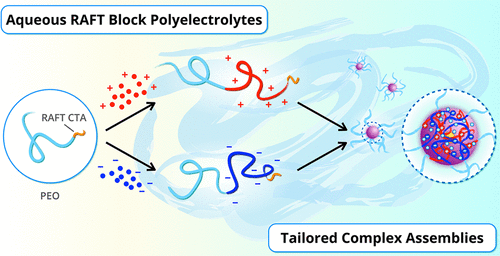当前位置:
X-MOL 学术
›
ACS Macro Lett.
›
论文详情
Our official English website, www.x-mol.net, welcomes your feedback! (Note: you will need to create a separate account there.)
Synthesis and Assembly of Designer Styrenic Diblock Polyelectrolytes
ACS Macro Letters ( IF 5.8 ) Pub Date : 2018-06-06 00:00:00 , DOI: 10.1021/acsmacrolett.8b00346 Jeffrey M Ting 1, 2 , Hao Wu 1 , Abraham Herzog-Arbeitman 3 , Samanvaya Srivastava 4 , Matthew V Tirrell 1, 2
ACS Macro Letters ( IF 5.8 ) Pub Date : 2018-06-06 00:00:00 , DOI: 10.1021/acsmacrolett.8b00346 Jeffrey M Ting 1, 2 , Hao Wu 1 , Abraham Herzog-Arbeitman 3 , Samanvaya Srivastava 4 , Matthew V Tirrell 1, 2
Affiliation

|
Harnessing molecular design principles toward functional applications of ion-containing macromolecules relies on diversifying experimental data sets of well-understood materials. Here, we report a simple, tunable framework for preparing styrenic polyelectrolytes, using aqueous reversible addition–fragmentation chain transfer (RAFT) polymerization in a parallel synthesis approach. A series of diblock polycations and polyanions were RAFT chain-extended from poly(ethylene oxide) (PEO) using (vinylbenzyl)trimethylammonium chloride (PEO-b-PVBTMA) and sodium 4-styrenesulfonate (PEO-b-PSS), with varying neutral PEO block lengths, charged styrenic block lengths, and RAFT end-group identity. The materials characterization and kinetics study of chain growth exhibited control of the molar mass distribution for both systems. These block polyelectrolytes were also demonstrated to form polyelectrolyte complex (PEC) driven self-assemblies. We present two simple outcomes of micellization to show the importance of polymer selection from a broadened pool of polyelectrolyte candidates: (i) uniform PEC-core micelles comprising PEO-b-PVBTMA and poly(acrylic acid) and (ii) PEC nanoaggregates comprising PEO-b-PVBTMA and PEO-b-PSS. The materials characteristics of these charged assemblies were investigated with dynamic light scattering, small-angle X-ray scattering, and cryogenic-transmission electron microscopy imaging. This model synthetic platform offers a straightforward path to expand the design space of conventional polyelectrolytes into gram-scale block polymer structures, which can ultimately enable the development of more sophisticated ionic materials into technology.
中文翻译:

Designer 苯乙烯二嵌段聚电解质的合成和组装
将分子设计原则用于含离子大分子的功能应用依赖于广为人知的材料的多样化实验数据集。在这里,我们报告了一种用于制备苯乙烯类聚电解质的简单、可调节的框架,该框架在平行合成方法中使用水性可逆加成-断裂链转移 (RAFT) 聚合。使用 (乙烯基苄基) 三甲基氯化铵 (PEO- b -PVBTMA) 和 4-苯乙烯磺酸钠(PEO- b ) 对一系列二嵌段聚阳离子和聚阴离子进行 RAFT 扩链-PSS),具有不同的中性 PEO 嵌段长度、带电苯乙烯嵌段长度和 RAFT 端基标识。链增长的材料表征和动力学研究显示了对两个系统的摩尔质量分布的控制。这些嵌段聚电解质也被证明可以形成聚电解质复合物 (PEC) 驱动的自组装体。我们提出了胶束化的两个简单结果,以显示从扩大的聚电解质候选物库中选择聚合物的重要性:(i )包含 PEO- b - PVBTMA 和聚(丙烯酸)的均匀 PEC 核心胶束和( ii)包含 PEO的 PEC 纳米聚集体- b -PVBTMA 和 PEO- b-PSS。通过动态光散射、小角 X 射线散射和低温透射电子显微镜成像研究了这些带电组件的材料特性。该模型合成平台为将传统聚电解质的设计空间扩展到克级嵌段聚合物结构提供了一条直接的途径,最终可以将更复杂的离子材料开发为技术。
更新日期:2018-06-06
中文翻译:

Designer 苯乙烯二嵌段聚电解质的合成和组装
将分子设计原则用于含离子大分子的功能应用依赖于广为人知的材料的多样化实验数据集。在这里,我们报告了一种用于制备苯乙烯类聚电解质的简单、可调节的框架,该框架在平行合成方法中使用水性可逆加成-断裂链转移 (RAFT) 聚合。使用 (乙烯基苄基) 三甲基氯化铵 (PEO- b -PVBTMA) 和 4-苯乙烯磺酸钠(PEO- b ) 对一系列二嵌段聚阳离子和聚阴离子进行 RAFT 扩链-PSS),具有不同的中性 PEO 嵌段长度、带电苯乙烯嵌段长度和 RAFT 端基标识。链增长的材料表征和动力学研究显示了对两个系统的摩尔质量分布的控制。这些嵌段聚电解质也被证明可以形成聚电解质复合物 (PEC) 驱动的自组装体。我们提出了胶束化的两个简单结果,以显示从扩大的聚电解质候选物库中选择聚合物的重要性:(i )包含 PEO- b - PVBTMA 和聚(丙烯酸)的均匀 PEC 核心胶束和( ii)包含 PEO的 PEC 纳米聚集体- b -PVBTMA 和 PEO- b-PSS。通过动态光散射、小角 X 射线散射和低温透射电子显微镜成像研究了这些带电组件的材料特性。该模型合成平台为将传统聚电解质的设计空间扩展到克级嵌段聚合物结构提供了一条直接的途径,最终可以将更复杂的离子材料开发为技术。



























 京公网安备 11010802027423号
京公网安备 11010802027423号